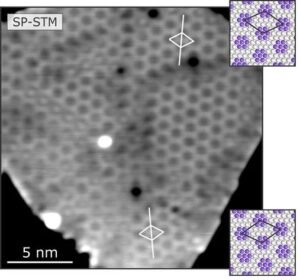A group of physicists from the universities of Kiel and Hamburg has discovered a new class of magnetic Nano Mosaics networks.
In the last ten years, magnetic skyrmions – stable, particle-like magnetic vortices that can form in certain materials and have interesting properties – have been the subject of research: easy control of electricity and few nanometers only, they are suitable for future applications. translated electronically, in a quantum computer or in a neuromorphic chip.
These magnetic (Magnetic Nano Mosaics) fields were observed in regular grids, called skyrmion grids, and later were observed individually at the University of Hamburg. Researchers from the University of Kiel (CAU) and the University of Hamburg have discovered a new class of automatic magnetic networks.
Although they are similar to skyrmion arrays, their nanometer-sized “atomic bar magnets” are oriented differently. A basic understanding of how these complex systems arise, how they are organized, and how they are stable, is also important for future applications.
The research team presented its results in the current issue of the scientific journal Nature Communications.
Quantum mechanics interactions
To apply a magnet to a refrigerator or to read data from a hard disk, it is necessary to synchronize the mechanical exchange between the magnetic poles at high speed. This relationship, discovered by Werner Heisenberg in 1926, explains not only the order of exchange of magnetic atomic poles in ferromagnets, but also the nature of other magnetic structures, for example antiferromagnets. Many other magnetic interactions are now known, leading to a large number of magnetic states and new research questions. Last but not least, this is very important for the skyrmion network, because here, the atomic magnetic field refers to all parts of space – this is possible only because of competition of various relationships.

Analysis of the Spin Polarization Spectroscopy (SP-STM) probe to visualize the hexagonal structure in the magnetic lattice at the nanoscale. Due to the destruction of the mosaic lattice and the atomic lattice, two sections of rotation appear that differ by about 13 degrees, see the symbol in the diagram on the right. Courtesy © André Kubetzka.
“In our measurements, we found a hexagonal arrangement of magnetic fields and initially thought it was a lot of metal. Only later did it become clear that it could be a nanoscale magnetic mosaic,” explains Dr Kirsten von Bergman. microscope. This makes it possible to map magnetic structures down to the atomic scale. The observed magnetic network appears at the same time as in a ferromagnet, i.e. without an applied magnetic field. Dr André Kubetzka, from the University of Hamburg, said: “We can use magnetic fields to rotate the mosaic lattice because the alternating elements compensate each other.”
Amazing: magnetically different supported
Based on these measurements, one Prof. Dr. Stefan Heinze (CAU) performed quantum computing on the supercomputers of the North German Association for High Performance Computing (HLRN). They show that in the metal film under investigation, the tendency of the atomic magnet in the network of magnetic fields, that is in all directions in space, is not good. Rather, almost parallels or anti-parallelisms of neighboring bar magnets appeal there.
“We were completely surprised by this result. “The wireless network can no longer be considered as an explanation for experimental research,” explains doctoral student Gutzeit, first author of the study. It was only with the development of the atomistic model that it became clear that there must be a new class of magnetic lattices, which the researchers called “mosaic lattices”. “We found that the high-order exchange rate, which was predicted only a few years ago, causes these magnetic mosaic structures,” said Dr. Kiel said.
“The study clearly shows how different types of bones can be and one of the advantages of the close relationship between the research team and the research process is for their understanding. We can expect a few surprises in this area in the future, ”Professor Stefan Heinze is some.

































